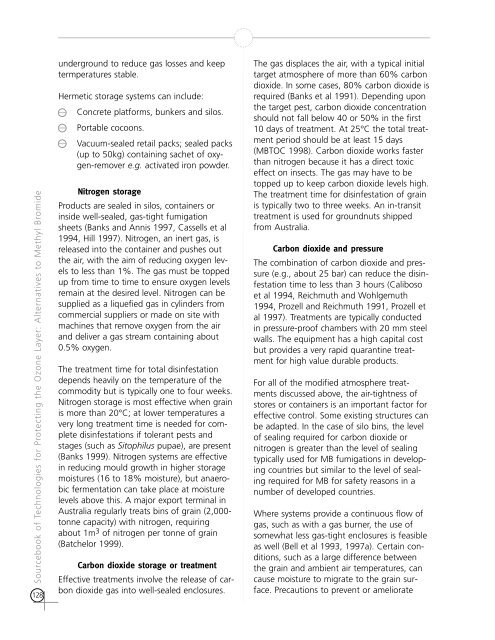Alternatives to Methyl Bromide - DTIE
Alternatives to Methyl Bromide - DTIE
Alternatives to Methyl Bromide - DTIE
You also want an ePaper? Increase the reach of your titles
YUMPU automatically turns print PDFs into web optimized ePapers that Google loves.
Sourcebook of Technologies for Protecting the Ozone Layer: <strong>Alternatives</strong> <strong>to</strong> <strong>Methyl</strong> <strong>Bromide</strong><br />
128<br />
underground <strong>to</strong> reduce gas losses and keep<br />
termperatures stable.<br />
Hermetic s<strong>to</strong>rage systems can include:<br />
Concrete platforms, bunkers and silos.<br />
Portable cocoons.<br />
Vacuum-sealed retail packs; sealed packs<br />
(up <strong>to</strong> 50kg) containing sachet of oxygen-remover<br />
e.g. activated iron powder.<br />
Nitrogen s<strong>to</strong>rage<br />
Products are sealed in silos, containers or<br />
inside well-sealed, gas-tight fumigation<br />
sheets (Banks and Annis 1997, Cassells et al<br />
1994, Hill 1997). Nitrogen, an inert gas, is<br />
released in<strong>to</strong> the container and pushes out<br />
the air, with the aim of reducing oxygen levels<br />
<strong>to</strong> less than 1%. The gas must be <strong>to</strong>pped<br />
up from time <strong>to</strong> time <strong>to</strong> ensure oxygen levels<br />
remain at the desired level. Nitrogen can be<br />
supplied as a liquefied gas in cylinders from<br />
commercial suppliers or made on site with<br />
machines that remove oxygen from the air<br />
and deliver a gas stream containing about<br />
0.5% oxygen.<br />
The treatment time for <strong>to</strong>tal disinfestation<br />
depends heavily on the temperature of the<br />
commodity but is typically one <strong>to</strong> four weeks.<br />
Nitrogen s<strong>to</strong>rage is most effective when grain<br />
is more than 20°C; at lower temperatures a<br />
very long treatment time is needed for complete<br />
disinfestations if <strong>to</strong>lerant pests and<br />
stages (such as Si<strong>to</strong>philus pupae), are present<br />
(Banks 1999). Nitrogen systems are effective<br />
in reducing mould growth in higher s<strong>to</strong>rage<br />
moistures (16 <strong>to</strong> 18% moisture), but anaerobic<br />
fermentation can take place at moisture<br />
levels above this. A major export terminal in<br />
Australia regularly treats bins of grain (2,000-<br />
<strong>to</strong>nne capacity) with nitrogen, requiring<br />
about 1m 3 of nitrogen per <strong>to</strong>nne of grain<br />
(Batchelor 1999).<br />
Carbon dioxide s<strong>to</strong>rage or treatment<br />
Effective treatments involve the release of carbon<br />
dioxide gas in<strong>to</strong> well-sealed enclosures.<br />
The gas displaces the air, with a typical initial<br />
target atmosphere of more than 60% carbon<br />
dioxide. In some cases, 80% carbon dioxide is<br />
required (Banks et al 1991). Depending upon<br />
the target pest, carbon dioxide concentration<br />
should not fall below 40 or 50% in the first<br />
10 days of treatment. At 25°C the <strong>to</strong>tal treatment<br />
period should be at least 15 days<br />
(MBTOC 1998). Carbon dioxide works faster<br />
than nitrogen because it has a direct <strong>to</strong>xic<br />
effect on insects. The gas may have <strong>to</strong> be<br />
<strong>to</strong>pped up <strong>to</strong> keep carbon dioxide levels high.<br />
The treatment time for disinfestation of grain<br />
is typically two <strong>to</strong> three weeks. An in-transit<br />
treatment is used for groundnuts shipped<br />
from Australia.<br />
Carbon dioxide and pressure<br />
The combination of carbon dioxide and pressure<br />
(e.g., about 25 bar) can reduce the disinfestation<br />
time <strong>to</strong> less than 3 hours (Caliboso<br />
et al 1994, Reichmuth and Wohlgemuth<br />
1994, Prozell and Reichmuth 1991, Prozell et<br />
al 1997). Treatments are typically conducted<br />
in pressure-proof chambers with 20 mm steel<br />
walls. The equipment has a high capital cost<br />
but provides a very rapid quarantine treatment<br />
for high value durable products.<br />
For all of the modified atmosphere treatments<br />
discussed above, the air-tightness of<br />
s<strong>to</strong>res or containers is an important fac<strong>to</strong>r for<br />
effective control. Some existing structures can<br />
be adapted. In the case of silo bins, the level<br />
of sealing required for carbon dioxide or<br />
nitrogen is greater than the level of sealing<br />
typically used for MB fumigations in developing<br />
countries but similar <strong>to</strong> the level of sealing<br />
required for MB for safety reasons in a<br />
number of developed countries.<br />
Where systems provide a continuous flow of<br />
gas, such as with a gas burner, the use of<br />
somewhat less gas-tight enclosures is feasible<br />
as well (Bell et al 1993, 1997a). Certain conditions,<br />
such as a large difference between<br />
the grain and ambient air temperatures, can<br />
cause moisture <strong>to</strong> migrate <strong>to</strong> the grain surface.<br />
Precautions <strong>to</strong> prevent or ameliorate
















